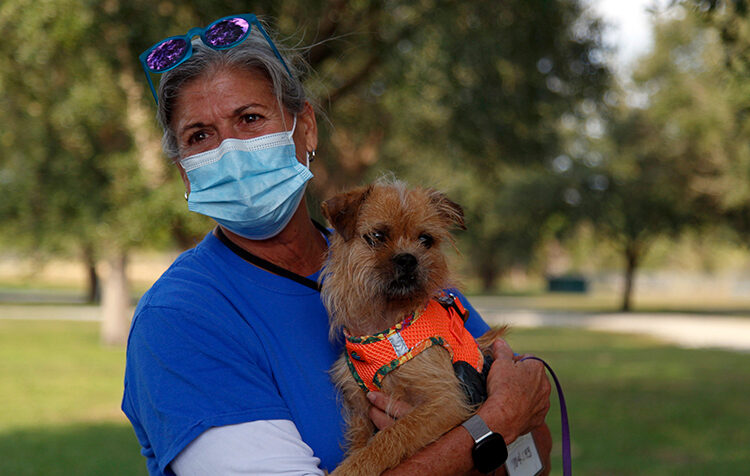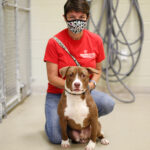
The Humane Society of Vero Beach and Indian River County began an expansion of its foster program in mid-March, after the pandemic forced the closure of the facility to anyone but staff.
Having foster parents for puppies and kittens is always particularly critical, as they need to eat or be bottle fed every couple of hours, yet the facility is closed overnight except for emergencies, explained Sherry Woodard, director of animal welfare, who started at HSVBIRC just two weeks before COVID hit.
“So, we put out a plea to the community that we absolutely needed help, and the community stepped up. It was just amazing how many people were willing to take animals home,” said Woodard.
“We weren’t open in the old sense of the word, but they could still help, and we could send animals home with them.”
The importance of the foster program cannot be understated. Many of the animals dropped off at the shelter have never lived in loving homes, and need to learn such basics as going through a doorway, up and down stairs, what a television is, and the appropriate place to relieve themselves.
“They’re all of the things that we want them to succeed at, so again, fostering is so important for them to have long-term success,” said Woodard.
The foster program was expanded over the course of the pandemic, and the process, which is explained on the shelter’s website, has been streamlined. Potential foster parents do go through training and are supplied with everything needed, from crates and food to medicines and even ‘Adopt Me’ vests to wear when walking dogs.
“We’re doing foster to adopt, where people can try an animal before making a commitment; I think that is happening across the country. And a lot of people are doing overnight fostering and weekend fostering, or people can foster for the holidays. That’s happened here for years,” said Woodard. “We can’t say enough good things about fostering and the way that it’s growing.”
Like shelters around the country, the Humane Society has switched to appointment-only visits, with photos and information about available animals on the website. People can no longer wander through the kennel.
“What we have learned is it’s much less stressful for the animals; the animals are all quiet and much more comfortable, which is good for them,” said Woodard. “We always knew that was the case, that they would rest in between groups of people coming through.”
Woodard said they are looking to grow their foster team. Although there is an endless need, the number of animals available to foster or adopt continually fluctuates.
“Even if it’s people that only want to foster short-term, or only want to do specifics, like they just want to do small dogs or they just want to do kittens,” said Woodard. “We have something for everyone. This is an ideal situation for snowbirds who are here for just a few months. They can bring a kitten home, bring a cat home, bring a dog home for a week or two to enjoy them and help them.”
“It’s so much fun,” said Becca Russell, a HSVBIRC volunteer, who with her husband has fostered about 20 different dogs over the past three years.
“We are in a unique situation because we have no other no pets, no kids; it’s just the two of us. So, we tend to foster dogs that are injured and recovering, or are shutting down here, getting overwhelmed.
“They need space to breathe and our goal is just to get them strong and confident and adoptable,” said Russell.
One of a foster parent’s biggest challenges is bringing them back, which, of course, is not a bad thing. Russell said they came close recently with Bill, an exceptionally large Bullmastiff that she described as an amazing, big, goofy dog, that everyone fell in love with.
“My neighbors talked about him for weeks after he left,” said Russell, adding that he found a forever home with a single woman. “I thought she needs Bill more than I do. That’s been the case with almost all of our fosters.”
Another challenge is dogs that aren’t house trained.
“I’ve gotten pretty good at that,” said Russell. “That’s something that fosters really do help with. Dogs have a hard time practicing being house trained in the shelter because it’s not a home.”
Fosters can keep an animal as long as needed, bringing them to the shelter when prospective adopters are interested. “I tend to keep them two weeks. That way they don’t get attached, but that’s just me. My first foster was for 2-1/2 months. The longer you have them, the harder it’s going to be,” said Russell.
One of her longer-time fosters had three strikes against him – a Pitbull mix with allergies who didn’t like children – that was eventually adopted by a young couple with no children and a big yard.
She related another foster story about a dog that she initially thought was boring. But after he had slept for hours, he was rested enough for his true personality to come out.
“I think that it’s important, not just fostering, but when you adopt a dog from here, to realize the dog you meet here is not the dog you’re going to have in your house,” Russell explained. “In 24 hours, they decompress, they look around, they get to know things, and then their personality comes out. I love finding those personalities.”
For more information, visit HSVB.org.
Photos by Kaila Jones












